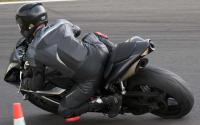Dynamic soft limits
- Rockwood
- Offline
- New Member
-

- Posts: 8
- Thank you received: 1
I'm not sure if this is the right place for this. But I'm working with a Tormach 1500MX that has a PathPilot control.
I built a complicated fixture for running the same part over and over. I wanted to have the soft limits prevent the tool from hitting the fixture. Which means having different X and Y limits when the Z axis is low enough to have the tool in the fixture. Also to prevent Z from lowering into the fixture unless X and Y are correctly positioned.
I ended up with this added to tormach's postgui hal file:
#rockwood edit , the below is for setting dynamic soft limits to protect from crashing into fixture when in "run" mode, "Setup" accessed with the built in tormach keyswitch, will have full travel. All units are inches.
#If Z < -3.187: X and Y limits switch to narrow windows (X:[14.349-15.175], Y:[5.674-6.559]); else use factory limits.
# Z min is -3.187 by default; becomes -11.494 when BOTH X and Y are within their narrow windows.
#load and name components I will need later, and2 components have to be added in "tormach_mill_ethercat_csp.hal"
loadrt mux2 names=mux.xMin,mux.xMax,mux.yMin,mux.yMax,mux.zMin,mux.zMinSetup
loadrt comp names=comp.zBelow,comp.x_ge_min,comp.x_le_max,comp.y_ge_min,comp.y_le_max
# add stuff to servo thread
addf comp.zBelow servo-thread
addf comp.x_ge_min servo-thread
addf comp.x_le_max servo-thread
addf comp.y_ge_min servo-thread
addf comp.y_le_max servo-thread
addf mux.xMin servo-thread
addf mux.xMax servo-thread
addf mux.yMin servo-thread
addf mux.yMax servo-thread
addf mux.zMin servo-thread
addf mux.zMinSetup servo-thread
addf not.setup-mode servo-thread
addf and.narrow servo-thread
addf and.znarrow servo-thread
addf and.xInWin servo-thread
addf and.yInWin servo-thread
addf and.xyInWin servo-thread
setp comp.x_ge_min.in0 14.349 # comp.x_ge_min.in0 is set to X narrow MIN setting
setp comp.x_le_max.in1 15.175 # comp.x_le_max.in1 is set to X narrow MAX setting
net motor.00.feedback-position comp.x_ge_min.in1 comp.x_le_max.in0 # current X postion is sent to *min.in0 and *max.in1
setp comp.y_ge_min.in0 5.674 # comp.y_ge_min.in1 is set to Y narrow MIN setting
setp comp.y_le_max.in1 6.559 # comp.Y_le_max.in1 is set to Y narrow MAX setting
net motor.01.feedback-position comp.y_ge_min.in1 comp.y_le_max.in0 # current Y postion is sent to *min.in0 and *max.in1
setp comp.zBelow.in1 -3.187 # set in1 to our fixture height threshhold:
net motor.02.feedback-position => comp.zBelow.in0 # assign current Z position to comp.zBelow.in0
net z-below-thresh comp.zBelow.out #create z-below-thresh this is true when Z is extended into the fixture
net x-ge-min comp.x_ge_min.out => and.xInWin.in0 # is X > than MIN?
net x-le-max comp.x_le_max.out => and.xInWin.in1 # is X < than MAX?
net x-inrange and.xInWin.out # if both are true than so is x-inrange
net y-ge-min comp.y_ge_min.out => and.yInWin.in0 # is Y > than MIN?
net y-le-max comp.y_le_max.out => and.yInWin.in1 # is Y < than MAX?
net y-inrange and.yInWin.out # if both then y-inrange
net x-inrange => and.xyInWin.in0
net y-inrange => and.xyInWin.in1
net both-inrange and.xyInWin.out # if both X and Y are in range, then both-inrange
#these mux contain the limit values.
setp mux.xMin.in0 -0.000001 #factory default
setp mux.xMax.in0 19.68500 #factory default
setp mux.yMin.in0 -0.000001 #factory default
setp mux.yMax.in0 13.77900 #factory default
setp mux.zMinSetup.in0 -14.0 #this is the factory default Min Z, IF we are in setup mode this should always be the value.
setp mux.zMinSetup.in1 -3.187 #this is a zMin just above the fixture. this is default when in run mode. it changes only when X and Y are in the narrow window.
setp ini.2.max_limit 0.000001 #setting Z max to factory limit. this is a fixed value.
# Narrow windows: X and Y
setp mux.xMin.in1 14.349
setp mux.xMax.in1 15.175
setp mux.yMin.in1 5.674
setp mux.yMax.in1 6.559
setp mux.zMin.in1 -11.494 #this is 1mm below cutting height, to be allowed only when x and y are within window
#modeswitchsig is from tormach, its TRUE when in setup mode. im flipping it and creating "not-setup" which just means run mode.
net modeswitchsig => not.setup-mode.in
net not-setup not.setup-mode.out
#if z-below-thresh and not setup, then we narrow x and Y windows
net z-below-thresh and.narrow.in0
net not-setup and.narrow.in1
net narrow-enable and.narrow.out
net narrow-enable mux.xMin.sel
net narrow-enable mux.xMax.sel
net narrow-enable mux.yMin.sel
net narrow-enable mux.yMax.sel
#mux.zmin setup just exists so we can go all the way down in setup mode
net not-setup mux.zMinSetup.sel
net z-min-default mux.zMinSetup.out mux.zMin.in0 #This assigns a default Zmin -3.187 if in "run" mode, -14 if in "setup mode"
#If X and Y are in the window and not-setup then set the Zmin mux to true, changing our z min value
net both-inrange and.znarrow.in0
net not-setup and.znarrow.in1
net z-narrow and.znarrow.out
net z-narrow mux.zMin.sel
# set axis limits min/max from the muxes
net x-min-dyn mux.xMin.out ini.0.min_limit
net x-max-dyn mux.xMax.out ini.0.max_limit
net y-min-dyn mux.yMin.out ini.1.min_limit
net y-max-dyn mux.yMax.out ini.1.max_limit
net z-min-dyn mux.zMin.out ini.2.min_limit
#Rockwood edit over
I've tested it, just jogging around and with MDI commands. It seems to be working. But this is my first time using linuxCNC. So I'd love a reality check from anyone more familiar. Does this make sense or is there a better way to do it? Am I adding too much to the servo thread? Is there something I should check to make sure I'm not slowing stuff down too much?
In the future, I want to get rid of all the hard-coded numbers. I want to store them in another file or at least one clear location in the postgui file. Preferably, I could process the "narrow window" numbers from a work offset, so I can move the fixture in the future and change the offset. But I would want to then lock that or all offsets from being edited easily, maybe using the same setup mode keyswitch. I'm not sure how to handle that yet. If anyone has ideas, I'd love to hear them.
Thanks for your time!
Please Log in or Create an account to join the conversation.
- andypugh
-

- Offline
- Moderator
-

- Posts: 19713
- Thank you received: 4570
You can look at the servo thread execution time with and without the added components to see if it is using a lot of CPU time, but it probably won't be.
Does Tormach include "halcompile" to create custom HAL components? If it does, then this is getting to the point where that might be worth doing.
linuxcnc.org/docs/stable/html/hal/comp.html
I always fancied the idea of being able to define limits as an STL file.
(STL because it's simple and easy to parse)
Please Log in or Create an account to join the conversation.
